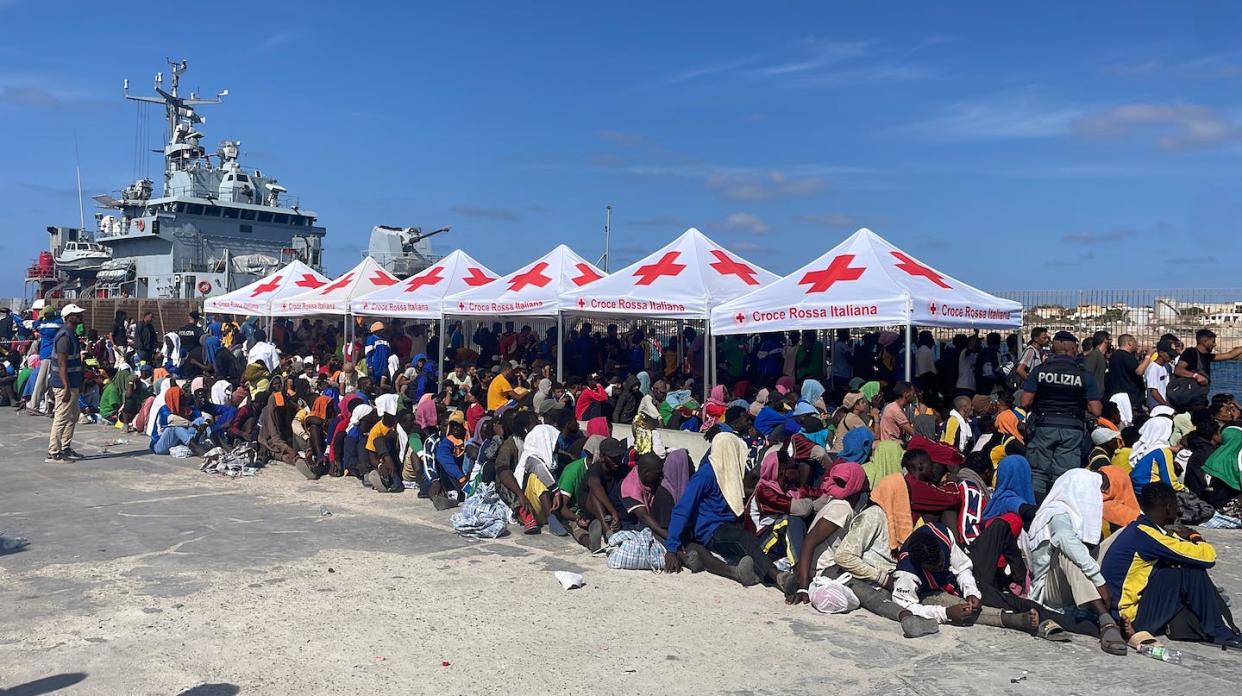What's happening on Lampedusa – and what Europe needs to do now to manage migration

In barely two days, between 12 and 14 September, more than 7,000 people arrived in around 120 small boats on the Italian island of Lampedusa, taking the number of arrivals up to 10,000 people by the middle of the month. This was a record-breaking figure for an island of around 6,000 inhabitants. Migrants are kept separate from the local population and identified before being transferred to Sicily or other centres in Italy.
A joint statement was issued in mid September by more than 80 NGOs condemning the overcrowded conditions in the reception centre, as well as its inability, with only 389 places, to adequately accommodate people.
According to InfoMigrants, more than 84,300 people arrived in Italy by sea between 1 January and 23 July, an increase of 144% on 2022. Of those, over half landed in Lampedusa. The European Border and Coast Guard Agency (Frontex) estimates that the central Mediterranean route accounted for half of the 232,350 “irregular border crossings” into the EU in the first eight months of 2023, the highest number for this period since 2016. However, the president of the Italian Red Cross Rosario Valastro, said the key challenge is not a matter of tallying up arrivals, but rather how to respond “to a humanity that is suffering”.
Who is arriving at Lampedusa?
The island of Lampedusa is situated a little over 100km from the Tunisian coast. On board the boats arriving in Lampedusa from Tunisia, there are refugees and migrants from various African countries. The majority are young men or unaccompanied minors, but there are also women, some of them pregnant, and children.
In previous years, the majority came from Libya, and were rescued by boats belonging to Italian rescue or humanitarian NGOs before reaching the island, according to the International Organization for Migration. It is likely that these numbers will increase again in the wake of recent catastrophic flooding in Libya.
There are contextual factors that lie behind the high number of arrivals. Storm Daniel, which also caused disaster in Libya, forced smugglers to suspend their operations for several days, creating a bottleneck in the coastal Tunisian city of Sfax. And the end of the summer is normally the time that sees the highest number of boat crossings before conditions worsen.
The socioeconomic situation in Tunisia has also worsened, with high inflation and a lack of jobs hitting residents hard. Hostility and violence towards sub-saharan African migrants have been evident. Earlier in 2023 the country’s president was condemned for comments about migrants from elsewhere on the continent. Many people who had lived and worked in Tunisia for years have left for Europe.
However, these factors do not explain why most people embark on migratory journeys. Many leave their countries fleeing persecution, or cannot return because their lives are in danger. Others who arrive in Lampedusa have found themselves forced to migrate due to climate change, political instability and lack of access to basic amenities or services. The term survival migrants is used to refer to these migrants who do not fit the definition of refugee according to the 1951 UN Convention Relating to the Status of Refugees.
The Commission’s 10 point plan
The President of the European Commission, Ursula von der Leyen, announced a 10-point plan the day after her visit to Lampedusa. Of the 10 points, some aim to help Italy manage the situation: these include; providing the support of the European Union Asylum Agency (EUAA) for registration and reception; aiding the transfer of people from Lampedusa; and consideration of alternatives such as enabling safe routes to discourage migrants from resorting to more dangerous ones.
Other measures include increasing returns, prevention of departures through the establishment of anti-trafficking partnerships in countries of origin and transit, and taking action against traffickers. There are also measures such as supporting fast-track classification and expulsion procedures and issuing entry bans.
Two measures of note in the plan are those on implementing the EU-Tunisia Memorandum of Understanding and on exploring options for expanding naval missions in the Mediterranean.
Since von der Leyen’s visit to Lampedusa on 17 September, rumours have been circulating that the EU is considering a naval blockade of dubious legality to prevent the arrival of migrants. This is a very different approach to the increased ship capacity that NGOs have repeatedly called for in response to the Pylos shipwreck – the biggest tragedy in the Mediterranean in recent years– and to combat the continued refusal of certain states to fulfil their search and rescue (SAR) obligations.
To this end, a new regional mechanism is much needed. This would be done via agreement with coastal states on the division of responsibilities for landing and disembarkation, and with non-coastal states on the issue of relocation. It has been reported that in 2023 most member states have not relocated a single refugee.
The implementation of the agreement with Tunisia, which the European Commission wants to turn into a model for other countries, has attracted strong criticism. The agreement has generated unease among EU member states, both because of the procedure leading to its approval and its content. The European Parliament has raised doubts and concerns about the extent of cooperation.
The required response
The short term priority for the EU needs to be supporting Italy so it can take in people who arrive and manage the situation better. The principle of mandatory solidarity which was agreed in June is fundamental to this, as it establishes a system for allocating asylum seekers among all EU member states.
Expanding legal routes into Europe is also a matter of urgency. Restrictive policies and fortified borders only lead to more irregular migration. Legal migratory routes will help governments to predict flows, and make pragmatic decisions about quotas, the needs of the labour markets and the costs and benefits of welcoming people.

